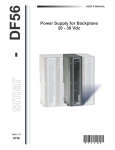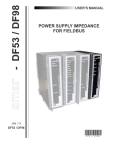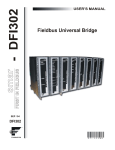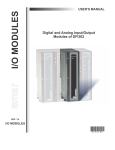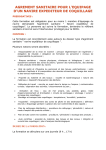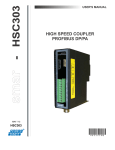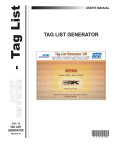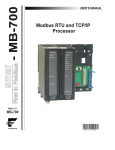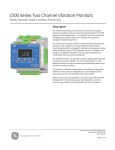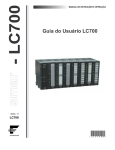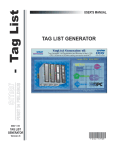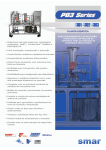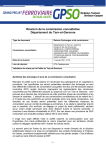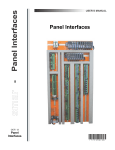Download DF50 – Power Supply Module for Backplane (90 to 264 Vac
Transcript
USER’S MANUAL Power Supply for Backplane 90 - 264 Vac MAR / 13 D F 5 0 M E smar www.smar.com Specifications and information are subject to change without notice. Up-to-date address information is available on our website. web: www.smar.com/contactus.asp DF50 – Power Supply for Backplane 90 – 264 Vac AVOIDING ELECTRICAL DISCHARGES ATTENTION Electrostatic discharges may damage semiconductor electronic components in printed circuit boards. They usually occur when touching components or connector pins from modules and racks, without wearing the appropriate equipment to prevent discharges. It is recommended to take the following precautions: • Before handling modules and racks, remove the electrostatic charge from your body by wearing a proper wristband or touching grounded devices; • Avoid touching electronic components or connector pins from racks and modules. 3 DF50 – User’s Manual 4 DF50 – Power Supply for Backplane 90 – 264 Vac DF50 – POWER SUPPLY FOR BACKPLANE 90 – 264 VAC Description This redundant power supply works independently or together with other redundant power supply module to ensure a constant supply of power for the application. When two redundant power supplies are used, if one of them fails, the backup will automatically assume the operation. A relay is provided to indicate failure on each power supply giving the user a chance to replace the faulty one. This module provides two voltage outputs: 5 Vdc @ 3 A: distributed by Power Lines in the Inter-Module-Bus (IMB) throughout the racks to supply the module circuits; 24 Vdc @ 300 mA: for external use through the terminals 1B and 2B. The applied AC voltage, the 5 Vdc and the 24 Vdc are all isolated between them. Installation and Configuration For systems based on DF92 and DF93 racks, with DF90 and DF91 Redundant mode options • Splitting Power concept: In this situation, two modules will supply power to a bus segment. If one of them was turned off or fails, the other power supply must be able to supply energy, alone, to the segment. The CH1 jumper (power supply) must be set in R position for both modules and W1 jumper (power supply) must be opened for both modules. • Standby concept: In this case, just one power supply provides energy to the system. If it was turned off or fails, the backup module will assume the operation. In both modules, the jumper CH1 (power supply) must be set in the R position and W1 jumper (power supply) must be placed only in the backup module. Expansion of load capacity by adding power supplies or pairs of redundant power supplies If the system consumption is greater than 3A, it can be subdivided in up to 8 groups sized for consumption of up to 3A each, and each group is individually powered by a power supply, or redundant pair of power supplies. More details on the Power supplies positioning topic. Power supplies positions in the racks On DF92, the pair of redundant power supplies must be installed in the first and second slots. On DF93 is recommended the placement of the redundant pair in the first and second slots, but it can be installed in any slots if necessary. Configuration of “W1” and “CH1” jumpers The DF50 CH1 jumper always must be connected to the R position. The W1 jumper (power supply) must be connected only in the DF50 modules configured as “backup”, in the standby concept, as above mentioned in the redundant mode options. For systems based on DF1A and DF78 racks Non-redundant (single module): power consumption limited to 3A: There is an addressing restriction related to the power supply location. The restriction is that the first rack (address 0) must always contain a power supply module at the first slot. In the power supply module the CH1 jumper must be set in E position. 5 DF50 – User’s Manual Non-redundant (more than one module): power consumption bigger than 3A: Additional modules are placed in the bus in parallel, but isolated one of the other. For systems based on DF1A rack, the power supplies modules must always be placed at the first rack’s slot. The jumper W1 (in the rack), where is the new power supply module, must be cut. The new power supply module will only supply power to the rack where it is sitting on and to the consecutive ones (never backwards). In all power supplies modules, the CH1 jumper must be set in E position. Redundant mode - Splitting power concept: In this case of redundancy, the user may have two power supplies modules in parallel in first and third slots of rack DF1A and first and second slots of rack DF78. The CH1 jumper (power supply) must be set in R position for both modules and W1 jumper (power supply) must be opened for both modules. In this situation, the two modules will supply power to the bus. - Standby concept: In this case, the main module must be placed in the first slot and the backup module in the third slot of rack DF1A or first and second slots of rack DF78. In both modules, the jumper CH1 must be set in the position R and W1 jumper must be placed only in the backup module. +5VDC +24VDC AC LINE AC Power Supply for Backplane STANDBY Air convection do not obstruct air flow! AC-R/50 AC Power Supply for Backplane DF50 Operating Range -10ºC to 60ºC 14ºF to 140ºF OUTPUT 24VDC 300mA 1B 2B 6W 30VDC Max. 200mA Max. CAUTION Fail V 90-264VAC Max 72VA 50/60Hz 3B 4B 5B 6B 7B FUSE 1.25A See manual smar BRN04 AC Power Supply Module: DF50 Technical Specifications INPUTS 6 DC 127 to 135 Vdc AC 90 to 264 Vac, 50/60 Hz (nominal), 47 to 63 Hz (range) Inrush Current < 36 A @ 220 Vac. [ΔT < 740 µs] Time until Power Fail 6 ms @ 102 Vac (120 Vac – 15%) [Full Load] Time until Shutdown 27 ms @ 102 Vac; > 200ms @ 220 Vac [Full Load] Maximum Consumption 72 VA Indicator AC LINE (green LED) DF50 – Power Supply for Backplane 90 – 264 Vac OUTPUTS a) Output 1 (internal use) 5.2 Vdc +/- 2% Current 3 A Maximum Ripple 100 mVpp Maximum Indicator +5 Vdc (green LED) Hold up Time > 40 ms @ 120 Vac [Full Load] b) Output 2 (external use) 24 Vdc +/- 10% Current 300 mA Maximum Ripple 200 mVpp Maximum Short Current Circuit 700 mA Indicator +24 Vdc (Green LED) ISOLATION Input signal, internal outputs and the external output are isolated between them. Between the Outputs and the Ground 1000 Vrms Between the Input and Output 2500 Vrms FAILURE RELAY Type of Output Solid state relay, normally closed (NC), isolated Limits 6 W, 30 Vdc Max, 200 mA Max Maximum Initial Contact Resistance <13 Ω Overload Protection Should be provided externally. Operation Time 5 ms maximum Operation TEMPERATURE -10 °C to 60 °C (14 ºF to 140 ºF) DIMENSIONS AND WEIGHT Dimensions (W x H x D) 39.9x137.0x141.5 mm; (1.57x5.39x5.57 in) Weight 0.450 kg CABLES One Wire 14 AWG (2 mm2) Two Wires 20 AWG (0.5 mm2) NOTES 1) 2) 3) 4) If the power consumption exceeds the power supplied, the DFI302 system may operate in an unpredictable manner that may causes damages to the equipment or risk of personal injury. Hence, the power consumption must be calculated correctly and install more power supplies modules, if it is necessary. To increase the service life of your contacts and protect the modules from potential reverse voltage damage, connect externally a clamping diode in parallel with each inductive DC load or connect an RC snubber circuit in parallel with each inductive AC load. The redundancy feature is only guaranteed for racks with GLL1270 Revision 2 or greater. For the models with their revisions less than the mentioned above, the technical support must be consulted in order to check the compatibility. To meet the EMC standards requirements, the wires’ length to the failure relay must be less than 30 meters. The power supply of activated load by the failure relay must not be from external network. 7 DF50 – User’s Manual Calculating the Power Consumption Since the power available in the power supply is limited, it is important to calculate the power consumption of modules in use. The user can create a worksheet to summarize all supplied and required current from each module and associated equipment (such as operator interface). Example of worksheet with the module’s consumption, and some power supplies’ specification. DFI302 Power Budget Module 8 Description Qty. 1 Consumption Unit Power (mA) Total Power (mA) Supply Unit Power (mA) Total Power (mA) @24 V @24 V @5 V @24 V @5 V 300 3000 300 3000 @5 V @24 V @5 V DF51 Controller 0 950 0 950 DF62 Controller 0 550 0 0 DF63 Controller 0 550 0 0 DF73 Controller 0 650 0 0 DF75 Controller 0 550 0 0 DF11 2*8 DI 24 Vdc 0 80 0 0 DF12 2*8 DI 48 Vdc 0 80 0 0 DF13 2*8 DI 60 Vdc 0 80 0 0 DF14 2*8 DI 125 Vdc 0 80 0 0 DF15 2*8 DI 24 Vdc (sink) 0 80 0 0 DF16 2*4 DI 120 Vac 0 50 0 0 DF17 2*4 DI 240 Vac 0 50 0 0 DF18 2*8 DI 120 Vac 0 87 0 0 DF19 2*8 DI 240 Vac 0 87 0 174 2 DF20 8 switches 0 45 0 0 DF44 8 AI 0 320 0 0 DF57 8 AI 0 320 0 0 DF45 8 Temperature inputs 0 55 0 0 DF21 16 DO (transistor) 65 70 0 0 DF22 2*8 DO (transistor) 65 70 0 0 DF23 8 DO (triac) 0 70 0 0 DF24 2*8 DO (triac) 0 115 0 0 DF25 2*4 DO (relay) 134 20 0 0 DF26 2*4 DO (relay) 134 20 0 0 DF27 2*4 DO (relay) 134 20 0 0 DF28 2*8 DO (relay) 180 30 0 0 DF29 2*4 DO (relay) 134 20 0 0 DF30 2*4 DO (relay) 134 20 0 0 DF31 2*4 DO (relay) 134 20 0 0 DF46 4 AO 180 20 0 0 DF32 8 DI 24 Vdc, 4 DO (relay) 67 60 0 0 DF33 8 DI 48 Vdc, 4 DO (relay) 67 60 0 0 DF34 8 DI 60 Vdc, 4 DO (relay) 67 60 0 0 DF35 8 DI 24 Vdc, 4 DO (relay) 67 60 0 0 DF36 8 DI 48 Vdc, 4 DO (relay) 67 60 0 0 DF37 8 DI 60 Vdc, 4 DO (relay) 67 60 0 0 DF38 8 DI 24 Vdc, 4 DO (relay) 67 60 0 0 DF39 8 DI 48 Vdc, 4 DO (relay) 67 60 0 0 DF40 8 DI 60 Vdc, 4 DO (relay) 67 60 0 0 DF53 4 Fieldbus Power Impedance 1500 0 1500 0 1500 1074 1 TOTAL 4 DF50 1 DF50 – Power Supply for Backplane 90 – 264 Vac DFI302 Power Budget Module Description Qty. DF52 1 TOTAL 6 Consumption Unit Power (mA) Total Power (mA) Supply Unit Power (mA) Total Power (mA) @24 V @24 V @5 V @24 V 1500 0 @5 V @24 V @5 V @5 V 1500 0 1800 3000 Power supplies and racks positioning For systems based on DF92 and DF93 racks with DF90 and DF91 A power supply connected to a rack, in a system, provides current to the racks row that are horizontally interconnected to it by their terminals of lateral connections, and vertically through DF90 cables, thus forming a group of rows of racks that use the same power supply. The system can have only one power supply (or pair of redundant power supplies) or it can be 1 subdivided in several of these groups , each one powered by a power supply (or pair of redundant power supplies). The recommended way to distribute the power is to divide the system in groups of horizontal rows of racks. In this scheme, each power supply must be positioned on the top left of the group of rows of racks that it powers. The rack were is the power supply must be the W1 jumper cut and the DF90 cable must not be connected to the rows powered by other power supplies (top rows). See in the following figure an example of system powered by two power supplies, each one powers a part of rows represented in green and blue. System powered by two power supplies Note that this system, for greater efficiency, is optimized for power distribution by groups of rows of racks. Thus, a power supply powers a whole number of rows it supports. However, in rare cases, with long rows or many modules with great consumption in the same row, there is the option to add power supplies in the middle of the row, dividing the power within this row. In this case, the power supply added powers only the modules positioned on the right in the same row, up to the end, or even where there is another power supply added. In the rack where the power supply was added, in this scheme, the W1 jumper must be cut and left lateral connection terminal (+5 Vdc) must be disconnected (collapsed). 1 Maximum 8 groups allowed when the DF50 or DF56 power supplies are used. 9 DF50 – User’s Manual In this system, DF50 must be its CH1 jumper always configured in R, even if it is not in redundant pairs. ATTENTION A mixture of these power supplies with the CH1 configured in R and in E in any DFI302 system, is not allowed! On DF92, the pair of redundant power supplies must be installed in the first and second slots. On DF93 is recommended the placement of the redundant pair in the first and second slots, but it can be installed in any slots if necessary. The system has diagnostic for voltage level distributed to racks. It also supports modules with great power consumption in any place on the bus. Nevertheless, is recommended to place those modules close to the power supplies, to avoid unnecessary power transmission. For systems based on DF78 and DF1A Racks (legacy systems) 1. Observe the maximum current values from the power supply module specification. The limit for DF50 is 3 A. 2. After the connection with long cables (DF4A, DF5A, DF6A and/or DF7A) you have to put another power supply module in the first slot of the first rack. 3. Use up to 6 modules DF44/DF57 per power supply; always place the DF44/DF57 consecutively and close to the power supply. Because of the high current consumption of the modules DF44/DF57, a not desired voltage drop in the bus can occur if these modules are placed after other modules. 4. When is necessary to add interface modules, such as HI302, MB700, DF58, in the same bus which is used by output and input modules, is recommended that these modules are placed close to the power supply, because in the same way as described in the previous item, a not desired voltage drop in the bus can occur if these modules are placed after other modules. 5. Adding a new power supply module • Determine the rack where the new power supply will be installed. • Cut the jumper W1 of the rack. • Plug the new power supply at the first slot of the rack (slot 0). • In this case, the CH1 jumper of all modules DF50 must be set in E position. 10 DF50 – Power Supply for Backplane 90 – 264 Vac Installing Modules in the Rack Follow the steps below to install a module in the rack. Attach the top of the module (with a 45o inclination) to the module support located on the upper part of the rack. Mounting detail. Push the module fixing it to the module connector. Next, fix the module to the rack using a screwdriver, and fasten the fixation screw at the bottom of the module. 11 DF50 – User’s Manual 12 Appendix SRF – SERVICE REQUEST FORM DFI302 – Fieldbus Universal Bridge Proposal Nº: COMPANY INFORMATION Company: _____________________________________________________________________________________________________ Unit: ________________________________________________________________________________________________________ Invoice: _______________________________________________________________________________________________________ COMMERCIAL CONTACT Full Name: ____________________________________________________________________________________________________ Phone: _________ _________________________ _________ _________________________ Fax: _______________________ E-mail: _______________________________________________________________________________________________________ TECHNICAL CONTACT Full Name: ________________________________________________________________________________________________ Phone: _________ _________________________ _________ _________________________ Extension: ____________________ E-mail: _______________________________________________________________________________________________________ EQUIPMENT DATA Model: ______________________________________________________________________________________________________ Serial Number: ________________________________________________________________________________________________ PROCESS DATA Process Type (Ex. boiler control): __________________________________________________________________________ Operation Time: ____________________________________________________________________________________________ Failure Date: __________________________________________________________________________________________________ FAILURE DESCRIPTON (Please, describe the failure. Can the error be reproduced? Is it repetitive?) ______________________________________________________________________________________________________________ ______________________________________________________________________________________________________________ ______________________________________________________________________________________________________________ ______________________________________________________________________________________________________________ OBSERVATIONS ______________________________________________________________________________________________________________ ______________________________________________________________________________________________________________ ______________________________________________________________________________________________________________ ______________________________________________________________________________________________________________ USER INFORMATION Company: _____________________________________________________________________________________________________ Contact: _______________________________________________________________________________________________________ Section: _______________________________________________________________________________________________________ Title: ________________________________________________ Phone: _________ _________________________ Signature:_______________________________________________ _________ _________________________ E-mail: ________________________________________________________________________ Extension: ___________________ Date: ______/ ______/ _________ For warranty or non-warranty repair, please contact your representative. Further information about address and contacts can be found on www.smar.com/contactus.asp A.1 DFI302 – User’s Manual A.2














